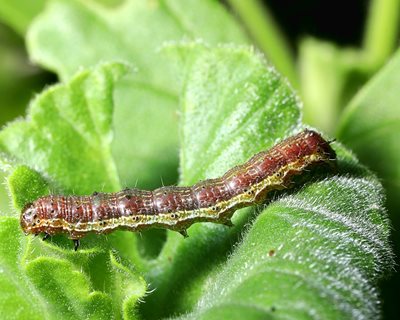How to Get Rid of Budworms in Your Garden
Learn several natural remedies for preventing budworms from ruining your petunias, geraniums, and other flowering plants.
Budworm on geranium leaves.
Have your beautiful petunias or geraniums suddenly stopped blooming? Is something chewing holes in the petals and gnawing through the unopened buds? The likely culprit is the tobacco budworm, a serious pest of tobacco and cotton crops that also likes to feast on the buds, petals, and foliage of many commonly grown garden flowers.
Also called the geranium or petunia budworm (to reflect its preferred diet), this destructive insect is the caterpillar of a certain moth species. It lays its eggs on the leaves or stems of the host plant. When the eggs hatch, the larvae burrow deep into the plant’s flower buds and begin their feeding frenzy.
Budworms are especially active in mid to late summer, when your flowers are at their peak of bloom. But in some parts of the country, they can be troublesome all year long. These pesky critters can cause significant damage to your plants in a short period of time. It’s important to act quickly before they get out of hand.
BUDWORM BASICS
Scientific name: Heliothis virescens
Common names: Tobacco budworm, petunia budworm, geranium budworm
Favorite host plants: Petunias, Supertunias, calibrachoa, flowering tobacco (Nicotiana sylvestris), geraniums, chrysanthemums, roses, snapdragons (Antirrhinum majus), and verbena. May also infest vegetables, including tomatoes, cabbage, lettuce, and peas.
Native region: North America, especially the eastern and southwestern United States.
Mature size: 1 to 1-3/4 inches long
Color: Typically green or light brown, with white stripes running lengthwise along the abdomen.
Period of peak activity: Mid to late summer. Can be active year-round in greenhouses, so some infestations may originate from plants purchased in spring.
HOW DO YOU KNOW IF YOU HAVE BUDWORMS?
Budworms can be very difficult to spot. Their greenish-brown color and small size (newly hatched larvae are barely over 1/16 inch long), make them masters of camouflage. Sometimes they will change color to match their food source, which makes them even harder to detect.
That means you often won’t know you have a problem until you see the first signs of damage. Watch for buds that won’t open and petals or leaves with jagged holes chewed into them.
To catch a budworm infestation as early as possible, carefully inspect your plants daily. Look for tiny grayish-white eggs on the undersides of the leaves and buds. The larvae may also deposit their droppings on the leaves, which look like small black seeds.
If you see any buds with noticeable holes or other signs of budworm damage, cut off and dispose of them right away. Egg-infested leaves should also be removed.
Budworms work fast. If not controlled, plants that were covered in flowers can lose most of their blooms in just a few days.
HOW DO YOU GET RID OF BUDWORMS?
Budworms, particularly mature larvae, are resistant to many common garden insecticides. The most effective method of removing them is to throw on a pair of garden gloves and pick them off by hand. Budworms are nocturnal feeders, so hunt for them at dusk or early in the evening when they are most active. During daylight hours, they often go into hiding around the base of their host plant.
If you have a large number of plants infested by budworms, manual removal may be impractical. Another method of eradicating them is to apply Bacillus thuringiensis, or Bt, a natural bacterium commonly used for pest control. This organic insecticide kills budworm larvae by attacking their digestive systems, but is harmless to children, pets, birds, and beneficial insects.
Bt is available in various formulations, including sprays and powders. But in order for the toxin to work, the timing of application is critical.
Bt is only effective if applied when the larvae are actively feeding on the surface of the plant. Once the caterpillars bore into the buds, the toxin is unlikely to be ingested.
For the best results, monitor your plants carefully for larval emergence and apply Bt according to label directions as soon as the first few eggs begin to hatch. Generally, you’ll need to reapply the product every 5 to 7 days until the infestation is gone.
TIPS FOR PREVENTING BUDWORMS
If you’ve been plagued by budworm infestations in the past, there are measures you can take to keep them out of your garden in the future. One easy solution is to stop growing petunias and geraniums altogether. But if you’re among the multitude of gardeners who love these gorgeous flowers, try these alternatives instead:
- Plant companion plants near flowers that are vulnerable to budworms. Aromatic plants like basil, sage, mint, and thyme can help keep budworms and other insect pests away with their strong odors.
- Attract birds and beneficial insects that prey on budworms, such as ladybugs, lacewings, and parasitic wasps.
- Consider growing plant varieties that are less susceptible to budworms. Ivy geraniums, for example, are not as enticing to budworms as are zonal geraniums.
- Repot container-grown geraniums in fresh soil before moving them into a garage or other indoor space for the winter. This will eliminate any pupae that might be overwintering in the soil.
- Become familiar with the early signs of a budworm infestation so you can get it under control quickly. Early spring, before your petunias and geraniums are in full bud, is the best time to begin regular inspections.
FAQS
What do tobacco budworms turn into?
The adult stage of the tobacco budworm is a moth with wings that are light green with gray or brown overtones and a wingspan of about 1¼ inches. The moths are most active in the early evening, which is when the females will lay their eggs on a plant’s flower buds and leaves to start the life cycle over again. Normally two generations of budworms are produced every year.
Will soapy water kill budworms?
Yes! Dropping the worms into a small pail of soapy water after picking them off your plants by hand is an effective way to kill them and make their disposal easier. If you release the worms elsewhere in your lawn or garden, they may find their way back onto your plants and resume their feeding frenzy.
Can I use chemical pesticides to banish budworms?
Controlling budworms with pesticides is unlikely to be effective once the caterpillars are burrowed within the buds where they feed. It is better to try natural or organic methods first and use chemical pesticides only as a last resort. Many pesticides can be highly toxic to bees and other pollinators, especially if your plant is already in bloom. They can also kill beneficial predatory insects that help to control budworm populations.
Can budworms survive cold winters?
In the winter, tobacco budworms take shelter below ground, where they hibernate as pupae until spring arrives. However, if exposed to extremely cold temperatures (below 20° F), the overwintering pupae are unlikely to survive. Budworms can overwinter happily in the soil of potted plants that were outdoors during the summer and then moved indoors to a warm location for the winter. They also may be active year-round in greenhouse-grown plants.
RELATED:
Tomato Plant Diseases, Pests, and Problems
Eco-Friendly Pest & Disease Control
